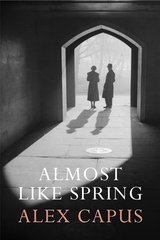7 books about Capus, Alex

Almost Like Spring
Alex Capus
Haus Publishing, 2014
With brilliantly vivid irony, a mosaic of voices tells the true story of Switzerland's most notorious bank robbers: Kurt Sandweg and Waldemar Velte. As 1933 draws to a close, the pair arrive in Basel from Wuppertal, Germany. Rebels on the run, they are searching for an escape from the confines of a callously regimented society left impoverished by the Depression and the onset of Nazi power. However, their desperation leads them to a realm outside reality, on a destructive path of vengeance for the world's abhorrent lack of justice. Resolute on their doomed mission, neither expected to fall in love. Seen through the benign eyes of Dorly Schupp, the agonising humanity of their relationships are sharply juxtaposed against the reckless cruelty of their crimes. Yet in a world equally heartless and unremitting, who should shoulder the blame? Capus relates the portrait of these chillingly charismatic figures in a curious blend of documentary and narrative where precision of detail collides with an economy of emotion, and leaves the desolation of their situation stark and blindingly poignant. Suspended between the tragic and comic, Capus's novel mimics the absurd idiosyncrasies of life where often nothing but interpretation is left to determine the sacred from the profane.
[more]

Leon and Louise
Alex Capus
Haus Publishing, 2011
Summer 1918. The First World War is drawing to a close when Léon Le Gall, a French teenager from Cherbourg who has dropped out of school and left home, falls in love with Louise Janvier. Both are severely wounded by German artillery fire, are separated, and believe each other to be dead. Briefly reunited two decades later, the two lovers are torn apart again by Louise's refusal to destroy Léon's marriage and by the German invasion of France. In occupied Paris during the Second World War, where Léon struggles against the abhorrent tasks imposed upon him by the SS, and the wilds of Africa, where Louise confronts the hardships of her primitive environment, they battle the vicissitudes of history and the passage of time for the survival of their love.
[more]

Life is Good
Alex Capus
Haus Publishing, 2018
Max has been married to Tina for twenty-five years. She is the love of his life, but now he must come to terms with the fact that she is to spend a year away on a work assignment—away, for the first time, from their home, their children and their life together. Her absence leaves him feeling like an Odysseus in reverse: he stays put whilehis Penelope goes out into the world.
Max, alone with his three teenage sons for the first time, is left contemplating life and the daily routine of the little bar of which he is the proprietor. As he spends more time with the regulars their problems begin to become his own. This new novel by Alex Capus is a hymn to trust, friendship and life’s small pleasures. Told with his trademark humor, Life is Good is a novel about finding contentment in rootedness as the world speeds up.
Max, alone with his three teenage sons for the first time, is left contemplating life and the daily routine of the little bar of which he is the proprietor. As he spends more time with the regulars their problems begin to become his own. This new novel by Alex Capus is a hymn to trust, friendship and life’s small pleasures. Told with his trademark humor, Life is Good is a novel about finding contentment in rootedness as the world speeds up.
[more]

A Matter of Time
Alex Capus
Haus Publishing, 2009
A little known backwater of the history of the Great War is vividly rendered by a great story-teller - the central characters and events of this book are based on fact, but their surroundings and experiences are richly drawn from the author's imagination and detailed research.
[more]

A Price to Pay
Alex Capus
Haus Publishing, 2014
Alex Capus’s novels have been runaway best-sellers in Germany, and his novel Léon and Louise received widespread critical acclaim on its English publication in 2012.
A Price to Pay, the fourth of Capus’s novels to be published in English, tells the interwoven stories of three disparate figures from interwar Switzerland: pacifist Felix Bloch, who ends up working on the Manhattan Project; Laura d’Oriano, who wants to become a singer but instead becomes an Allied spy in fascist Italy; and Emile Gillieron, who accompanies Heinrich Schliemann to Troy and becomes one of art’s greatest forgers. Taking off from the only moment in history when all three were in the same place—a November day in 1924 at Zürich Station—Capus traces their diverging paths as they secure their places in the annals of history—but at what price?
A Price to Pay, the fourth of Capus’s novels to be published in English, tells the interwoven stories of three disparate figures from interwar Switzerland: pacifist Felix Bloch, who ends up working on the Manhattan Project; Laura d’Oriano, who wants to become a singer but instead becomes an Allied spy in fascist Italy; and Emile Gillieron, who accompanies Heinrich Schliemann to Troy and becomes one of art’s greatest forgers. Taking off from the only moment in history when all three were in the same place—a November day in 1924 at Zürich Station—Capus traces their diverging paths as they secure their places in the annals of history—but at what price?
[more]

Sailing by Starlight
In Search of Treasure Island
Alex Capus
Haus Publishing, 2011
Capus takes us on an exploratory journey via the loss of a Spanish vessel laden with gold and jewels in the South Seas, the burial of treasure, an ancient map, and a long and dangerous voyage across the Pacific, to prove that Robert Louis Stevenson's "treasure island" actually exists; and that it exists in a place quite different from where hordes of treasure-hunters have been seeking it for generations. In fact, he posits, it was for this reason alone that Stevenson spent the last five years of his life in Samoa. On a long trip round the Pacific islands with the idea of writing articles for American periodicals, Stevenson, travelling with his beloved wife, Fanny, and stepson Lloyd Osbourne, had no notion of stopping at Samoa when their ship made landfall in December 1889. Yet, only six weeks later, at the age of 39, he would invest all his available assets in a patch of impenetrable jungle and spend the rest of his life there. This book traces what led Stevenson to Samoa and the origins of his famous story. For facing him from this unlikely spot was another island – a conical isle, Tafahi, where legends abound, and it was, Capus suggests, this isle that would cause him to change the course of his life.
[more]

Skidoo
A Journey through the Ghost Towns of the American West
Alex Capus
Haus Publishing, 2013
Decades after westward expansion swept over it, settled it, and domesticated it, the Wild West remains a potent source of American myth and mystery. But the actual history, and the traces of it that remain, are at least as interesting as the fiction, and in Skidoo, writer and novelist Alex Capus takes us on a fascinating tour of the skeleton of the American West—the ghost towns and collapsing mines that lie far from interstates and airports, lost in history.
Walking in the footsteps of bank robbers and grave diggers, desperadoes and Native Americans, beer brewers and child brides, Capus uncovers story after story of adventure, violence, and exploration. Near Salt Wells, Nevada, he learns the story of a luckless inventor whose corpse was discovered frozen in the desert, an icicle hanging from its nose. In Skidoo, California, he tells us of a brawling bartender, Hootch Simpson, who was hanged twice—once by a mob, once by the law—before being beheaded during his autopsy. And in Flagstaff, Arizona, Capus traces the long-lost origins of Route 66, as a narrow, isolated trail for Edward Fitzgerald Beale’s Camel Corps.
Packed with period detail, and told with a verve and enthusiasm to rival Pecos Bill, the stories in Skidoo are sure to enchant any lover of Western tales or America’s wild history.
Walking in the footsteps of bank robbers and grave diggers, desperadoes and Native Americans, beer brewers and child brides, Capus uncovers story after story of adventure, violence, and exploration. Near Salt Wells, Nevada, he learns the story of a luckless inventor whose corpse was discovered frozen in the desert, an icicle hanging from its nose. In Skidoo, California, he tells us of a brawling bartender, Hootch Simpson, who was hanged twice—once by a mob, once by the law—before being beheaded during his autopsy. And in Flagstaff, Arizona, Capus traces the long-lost origins of Route 66, as a narrow, isolated trail for Edward Fitzgerald Beale’s Camel Corps.
Packed with period detail, and told with a verve and enthusiasm to rival Pecos Bill, the stories in Skidoo are sure to enchant any lover of Western tales or America’s wild history.
[more]
READERS
Browse our collection.
PUBLISHERS
See BiblioVault's publisher services.
STUDENT SERVICES
Files for college accessibility offices.
UChicago Accessibility Resources
home | accessibility | search | about | contact us
BiblioVault ® 2001 - 2024
The University of Chicago Press









